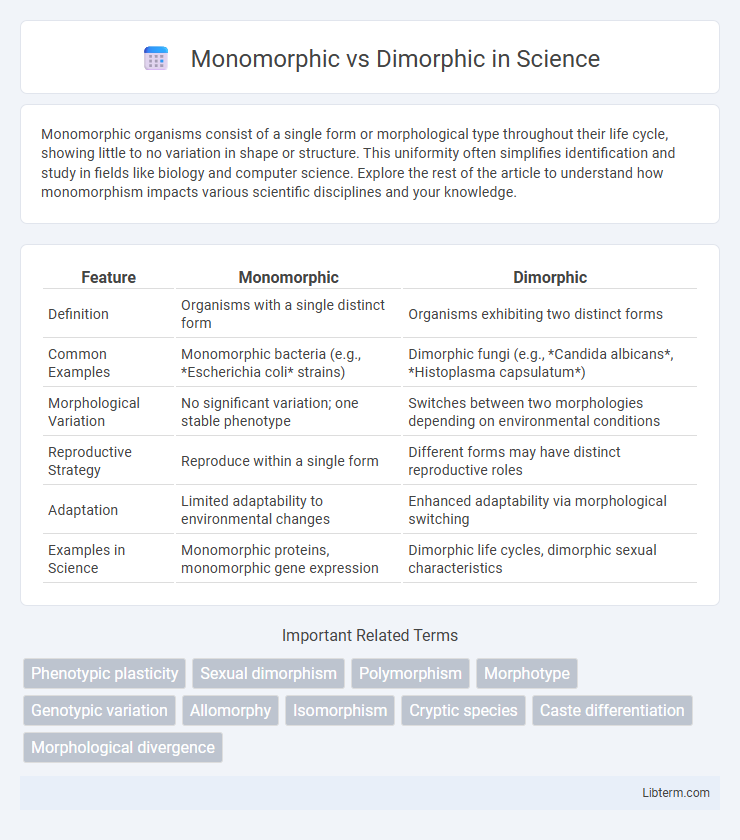Monomorphic organisms consist of a single form or morphological type throughout their life cycle, showing little to no variation in shape or structure. This uniformity often simplifies identification and study in fields like biology and computer science. Explore the rest of the article to understand how monomorphism impacts various scientific disciplines and your knowledge.
Table of Comparison
| Feature | Monomorphic | Dimorphic |
|---|---|---|
| Definition | Organisms with a single distinct form | Organisms exhibiting two distinct forms |
| Common Examples | Monomorphic bacteria (e.g., *Escherichia coli* strains) | Dimorphic fungi (e.g., *Candida albicans*, *Histoplasma capsulatum*) |
| Morphological Variation | No significant variation; one stable phenotype | Switches between two morphologies depending on environmental conditions |
| Reproductive Strategy | Reproduce within a single form | Different forms may have distinct reproductive roles |
| Adaptation | Limited adaptability to environmental changes | Enhanced adaptability via morphological switching |
| Examples in Science | Monomorphic proteins, monomorphic gene expression | Dimorphic life cycles, dimorphic sexual characteristics |
Introduction to Monomorphic and Dimorphic Concepts
Monomorphic organisms exhibit a single distinct form or morphology throughout their life cycle or within a population, while dimorphic organisms display two distinct forms, often related to gender or developmental stages. This concept is crucial in biology for understanding variations in species traits, such as sexual dimorphism where males and females have different physical characteristics. Analyzing monomorphic and dimorphic traits informs studies in evolution, ecology, and species behavior.
Defining Monomorphism
Monomorphism refers to a biological condition where a species exhibits a single form or morphology within its population, meaning all individuals share the same physical characteristics and appearance. This contrasts with dimorphism, where two distinct morphs or forms exist, often related to differences between sexes or other factors. Understanding monomorphism is crucial for studying species with uniform traits, aiding in taxonomic classification and evolutionary biology.
Understanding Dimorphism
Dimorphism refers to the occurrence of two distinct forms, often within a species, and is most commonly observed as sexual dimorphism, where males and females exhibit different physical traits. Understanding dimorphism is crucial for studying biodiversity, evolutionary adaptation, and reproductive strategies, as it highlights the role of genetic and environmental factors in shaping organismal differences. Examples of dimorphic species include peacocks, where males have elaborate plumage while females do not, and many insect species that display size or color variations between sexes.
Key Differences: Monomorphic vs Dimorphic
Monomorphic species exhibit only one distinct form or phenotype within a population, while dimorphic species display two distinct forms, often related to sex or morphological traits. Monomorphism typically results in uniformity in appearance or behavior, whereas dimorphism promotes diversity, frequently linked to reproductive roles or environmental adaptation. The key difference lies in the number of phenotypic variations, directly influencing mating strategies, survival, and evolutionary dynamics.
Biological Examples of Monomorphism
Monomorphism in biology refers to species or populations where individuals exhibit a single, uniform phenotype or morphological form, such as the roundworm Caenorhabditis elegans, which shows consistent body shape across its population. Another example includes many unicellular organisms like Amoeba proteus, exhibiting a single form without polymorphic variations. This monomorphic trait contrasts with dimorphism, where two distinct forms or morphs are present within a species, such as in sexual dimorphism seen in many bird species.
Common Occurrences of Dimorphism in Nature
Dimorphism often appears in species where males and females exhibit distinct physical differences, such as size, coloration, or morphology, frequently seen in birds like peacocks and fish like anglerfish. In plants, sexual dimorphism manifests in flower structure or reproductive organs between male and female plants, common in species like willows and holly. These differences enhance reproductive success by aiding in mate recognition, competition, and niche differentiation within ecosystems.
Genetic and Environmental Influences
Monomorphic traits express a single genetic form within a population, often stabilized by strong genetic regulation and limited environmental effect, resulting in uniform phenotypes. Dimorphic traits exhibit two distinct genetic forms frequently influenced by environmental factors that interact with genetic predispositions to determine phenotype variability. Genetic mechanisms such as allelic variation and gene expression patterns, combined with environmental influences like temperature or nutrition, critically shape the manifestation of monomorphic and dimorphic characteristics.
Evolutionary Significance
Monomorphic species exhibit uniform physical traits across individuals, which may enhance group cohesion and reduce energy spent on mate competition, stabilizing their ecological niche. Dimorphic species, displaying distinct male and female morphologies, facilitate sexual selection and reproductive success by promoting diverse mating strategies and adaptability. Evolutionarily, dimorphism often drives genetic variation and species resilience, while monomorphism supports consistent survival in stable environments.
Impacts on Species Survival and Adaptation
Monomorphic species, exhibiting uniform physical traits, often benefit from stability in specific environments but may face challenges adapting to rapid ecological changes, limiting their long-term survival. Dimorphic species, characterized by distinct morphological differences between sexes or forms, enhance genetic diversity and adaptive potential, increasing resilience to environmental fluctuations. These variations influence reproductive strategies and resource utilization, directly impacting species' evolutionary success and ecological niche optimization.
Conclusion: Choosing Between Monomorphic and Dimorphic Traits
Choosing between monomorphic and dimorphic traits depends on the specific biological context and adaptive advantages required for a species. Monomorphic traits promote uniformity and stability within populations, while dimorphic traits often enhance reproductive success through distinct male and female characteristics. Evaluating environmental pressures and evolutionary goals helps determine the optimal balance for survival and reproduction.
Monomorphic Infographic

 libterm.com
libterm.com